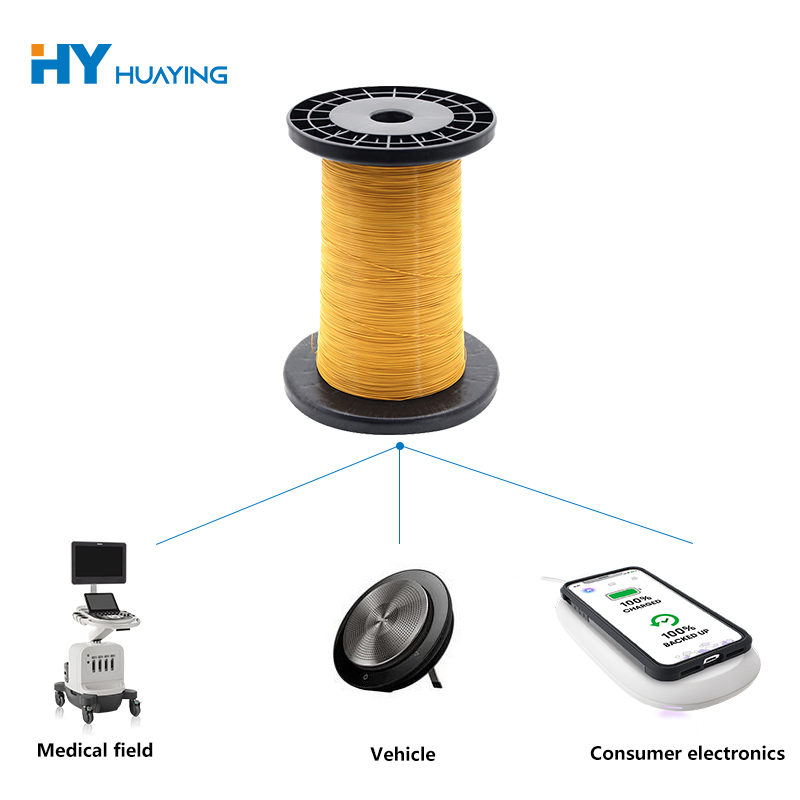What Are the Layers of Insulation In a Triple Insulated Wire?
2025-11-21
A Triple Insulated Wire is engineered for high-voltage isolation, compact transformer design, and long-term electrical safety. In many power-supply applications, manufacturers rely on its multi-layer insulation structure to ensure reliability without adding bulky secondary insulation. At Huizhou Huaying Electronics Technology Co., Ltd., our factory focuses on precision manufacturing, allowing our Triple Insulated Wire to meet both international safety expectations and modern efficiency requirements. In this article, we explain the insulation layers, outline technical parameters, and detail why our solutions remain preferred across global electronics industries.
Understanding the Three Insulation Layers
The core advantage of a Triple Insulated Wire is its three independent insulation layers, each designed to provide functional electrical protection. Our production team follows strict quality standards to ensure consistent thickness, resilience, and temperature resistance. Below is a clear breakdown of each layer to help engineers evaluate suitability for demanding converter, charger, and transformer applications at Huizhou Huaying Electronics Technology Co., Ltd.
1. Primary Inner Insulation Layer
The innermost layer is tightly bonded to the conductor, enhancing dielectric strength and preventing micro-cracks. Our manufacturing process ensures uniform coverage, helping the conductor maintain stability during high-frequency operations.
2. Secondary Middle Insulation Layer
This middle layer reinforces electrical protection while maintaining flexibility. By adding an additional insulating barrier, our wire structure can withstand voltage spikes and harsh temperature variations in compact electronic modules.
3. Tertiary Outer Insulation Layer
The outermost layer provides mechanical defense, surface durability, and additional dielectric reinforcement. Our factory adopts materials with excellent abrasion resistance, making the finished wire suitable for transformer winding methods where tension and friction are common.
Technical Specifications of Our Triple Insulated Wire
Below is a structured specification table to help engineers evaluate compatibility with their designs. The data reflects real design configurations from Huizhou Huaying Electronics Technology Co., Ltd. and illustrates the performance advantages of our insulation technology.
| Conductor Material | High-purity copper, oxygen-free, precision drawn |
| Insulation Structure | Three independent layers: inner, middle, outer |
| Thermal Class | Up to 155°C or 180°C depending on model |
| Breakdown Voltage | Exceeds industry standards for reinforced insulation |
| Outer Diameter Range | Customized based on customer requirements |
| Dielectric Strength | Enhanced multi-layer protection for compact transformers |
| Mechanical Durability | High resistance to abrasion and winding stress |
| Certifications | Compliant with international insulation safety requirements |
Why Choose Triple Insulated Wire for Modern Electronic Designs?
Engineers often select this wire type to simplify transformer construction while meeting insulation safety requirements. Our factory ensures dimensional stability, heat resistance, and consistent dielectric strength across all production batches. Huizhou Huaying Electronics Technology Co., Ltd. frequently supports power-supply manufacturers who need a reliable winding material that reduces the need for additional tapes, barriers, and margins during assembly.
Another key advantage is design flexibility. With our precision manufacturing capabilities, we help customers integrate triple-insulated wire into compact layouts without sacrificing isolation performance. This is especially important for switching-mode power supplies, EV chargers, adapters, and smart appliances where efficiency and miniaturization are crucial.
Key Manufacturing Advantages of Our Factory
Our process focuses on consistent insulation thickness and strong bonding strength. At Huizhou Huaying Electronics Technology Co., Ltd., we prioritize stable extrusion quality, enabling our customers to achieve predictable electrical performance in every winding. We also implement high-temperature aging tests, abrasion tests, and dielectric breakdown evaluations to ensure long-term reliability.
When working with global builders of industrial electronics, our team actively collaborates to customize specifications based on coil size, operational voltage, and thermal requirements. These professional adjustments help ensure every product from our factory meets targeted industry expectations.
Performance Benefits in High-Frequency Applications
High-frequency circuits require insulation that can withstand rapid switching conditions. Our three-layer configuration provides improved dielectric stability, reducing the risk of partial discharge during high-frequency cycles. Huizhou Huaying Electronics Technology Co., Ltd. continues to refine material formulations to improve heat dispersion and extend service life, especially in compact transformer cores where thermal pressure is high.
The multilayer insulation structure also reduces the need for secondary insulation materials, helping product designers save space while maintaining reinforced safety performance. This is one of the main reasons many brands choose our Triple Insulated Wire for mass-production environments.
FAQ: What Are the Layers of Insulation In a Triple Insulated Wire?
1. Why does a Triple Insulated Wire require three insulation layers?
The three layers provide reinforced electrical protection without relying on external barriers. Each layer functions independently, allowing our products to meet higher safety margins while improving space efficiency inside transformers.
2. How does each insulation layer contribute to electrical safety?
The inner layer stabilizes the conductor, the middle layer enhances dielectric strength, and the outer layer protects against abrasion and mechanical stress. Together, these layers ensure that our wire maintains consistent performance in high-frequency and high-temperature environments.
3. Can Triple Insulated Wire reduce the need for additional insulation materials?
Yes. The three-layer structure often replaces tapes or tubing traditionally used for reinforced insulation. This allows our factory to help customers simplify winding processes, improve product density, and reduce assembly steps without compromising safety.
Conclusion
Triple Insulated Wire remains a preferred solution for modern electronics requiring compact design and superior electrical isolation. At Huizhou Huaying Electronics Technology Co., Ltd., our factory applies strict manufacturing standards to ensure every batch meets customer expectations for reliability, performance, and durability. Through advanced extrusion techniques and rigorous testing, we continue supporting global manufacturers seeking durable and efficient winding materials for transformers and power-supply architectures.
